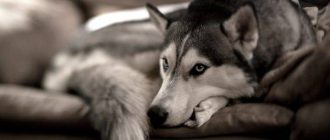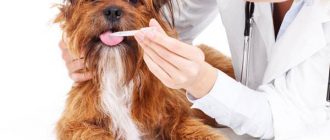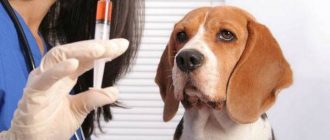Discharge from the loop in dogs after childbirth makes you nervous inexperienced owners. But this is a normal physiological the process that accompanies postpartum activity. So as not to to worry in vain and not to irritate the dog, the owner should know which discharge is the norm, and in which cases should seek medical attention immediately.
Content
- 1. Normal postpartum discharge
- 2. Allocations for postpartum pathology
- 3. Postpartum Precautions
Normal postpartum discharge
Normally, from the birth canal in a congenital bitch for another 3-6 weeks, mucous membranes, blood cells or mixed with blood, discharge – lochia. Gradually, their number should decrease and end completely at the end. Process however the natural cleansing of the uterus must be controlled so as not to miss the alarming symptoms of pathology. Normally, separable from the hinge changes its texture and color. The first few days from the moment of birth, normally Lochia can look like this:
- grayish or light green discharge, dense texture with interspersed – it is from the uterine cavity that the remains of the amniotic come out fluids and fragments of the placenta. The smell of the discharge should not cause disgust;
- Lochia of dark, almost black color without putrefactive odor – also considered normal. The dark color of the mucus gives curled blood from the capillaries, which flows when the placenta exits;
- dark mucus with a brownish or greenish tint – this uterus and traces of blood in the amniotic fluid and mucus.
If the lochia is not too plentiful, and have a normal consistency and smell, then you should not worry. Loops can first a few days accompanied by low-grade body temperature and physiological diarrhea, which usually ends through 1-2 days.
Owners may be alerted by the dog’s strange behavior – she starts behaving like a few hours before the bouts:
- leaves the nest;
- fussing;
- digs a litter;
- breathing heavily and intermittently.
Some confuse this behavior with symptoms of “milk fever” – eclampsia. But the cause is the dog’s discomfort, which cause uterine contractions and irritation of the sensitive nipples when feeding puppies. 
As a rule, this condition goes away on its own, but for safety net you can consult with your veterinarian. Give dog mild sedative and analgesic – No-shpu or Baralgin in dosage, depending on the size of the pet. Fears should occur if lochia become more abundant or unpleasant smell.
Postpartum discharge
The cause of abnormal discharge may be as inflammatory process with infection and trauma of the reproductive organs, and consequences of intrauterine death of puppies. Are considered pathological allocation of the following composition:
- Liquid abundant secretions mixed with blood can testify about the not completely departed child’s place. When if the cervix contracted too quickly, then the remnants placentas remain in the uterine cavity, causing an inflammatory process. Subsequently, a secondary infection may join, and in the lochia pus will appear. In this case, urgent consultation is required. a veterinarian who is using uterine stimulating drugs reduction, help clear it of its contents.
- Dark discharge with a putrid odor may indicate the process of decomposition of fragments of the placenta or the dead fetus. At intoxication with decomposition products in a dog febrile fever, signs of fever, muscle weakness and refusal to eat. Emergency medical care consists in the operative removal of an organ or cleaning it with subsequent drug therapy.
- Profuse spotting of dark or bright scarlet color signal uterine bleeding or rupture of the uterus. If a do not take action on time, then profuse blood loss can lead to death of a pet.
Any warning signs, change in behavior or condition animal require specialist advice. If the owner is not sure if the discharge is normal, you should invite a veterinarian to the house so that he inspects the dog. But even with a normal process uterine cleansing measures should be taken to prevent risk postpartum infection.
Interesting:
- how do ultrasound dog;
- diets for dogs;
- beriberi in dogs.
Postpartum Precautions
In the periods between estrus and childbirth, the cervix is closed, which prevents the penetration into the uterine cavity of the infection. More on for several weeks the cervix is ajar, which promotes free release of residues amniotic fluid and placenta. During this period, the entrance pathogens is not limited and therefore should observe precautions:
- immediately after birth, change the litter in the “nest” with traces of blood and amniotic fluid;
- Do not prevent the dog from licking the loop. In her saliva contains enzymes that promote blood coagulation and provide disinfecting effect;
- change the litter of the dog daily, avoiding contamination and creasing;
- wash the animal not only after childbirth, but also subsequently after each urination and bowel movement;
- to avoid congestion in the uterus, it should be done once douching with a warm synthomycin solution per week emulsions;
- avoid overcooling or overheating of the animal;
- food and water are placed near the “nest” so that the dog does not nervous, leaving the litter;
- Bring the dog out for sparing care – you must not allow her to actively move and walk for a long time.
Compliance with the listed rules of prevention in the postpartum period will reduce the risk of infection and postpartum complications.






